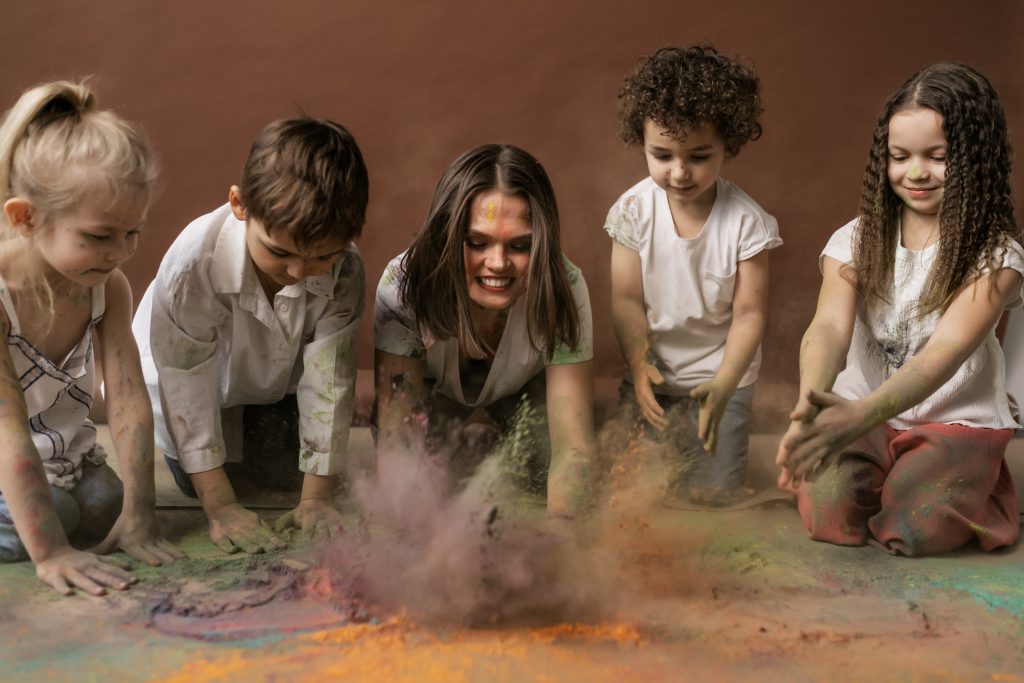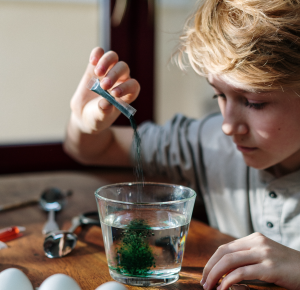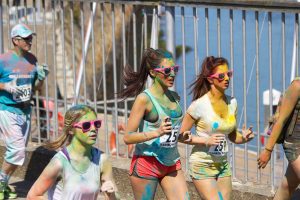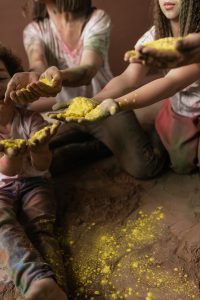- 833-265-6771
- [email protected]
- Mon - Fri: 8:00 - 5:00 EST

Every teacher knows the importance of developing exciting lesson plans to keep their students interested and motivated. You can create a classroom environment that goes beyond your students’ expectations with color powder. Using color powder as a vibrant teaching aid creates opportunities for engaging and interactive learning experiences for your students.
As an educator, your dream is to have your students actively participate in the learning process, to be excited about learning, and engaged in their lessons. Color powder can make that dream a reality. Whether it’s mixing colors, creating artwork, or engaging in physical activities, color powder promotes a hands-on approach that is simply irresistible to students.
By activating multiple senses like sight, touch, and even smell, color powder helps students grasp abstract concepts more easily, making the subject matter memorable and impactful.
The vibrant colors of the powder serve as a visual aid that not only captures students’ attention but also acts as a medium for their creativity to shine. Students can explore different color combinations in real-time, adding powder to their creations – fostering artistic expression and original thinking.
Color powder can promote a positive learning environment, adding an element of fun and excitement to the classroom, where students are motivated to participate and explore. The joyful experiences with color powder can promote a positive attitude in your students about learning and their overall education.
Using color powder in school lessons adds a dynamic and interactive element that enhances student engagement, creativity, and overall learning.
The versatility of color powder is truly remarkable. It offers a wide range of applications and activities that can be adapted to different subjects, age groups, and learning levels. Whether you teach pre-K or high school, color powder can provide an experiential learning opportunity.
Color powder allows students to explore their creativity and provides a medium for self-expression, enabling students to showcase their understanding in unique and visually appealing ways.
Color powder creates visual demonstrations for subject matter, making it easier for students to grasp more abstract or analytical concepts , especially those who are primarily visual or kinesthetic learners. Sensory experiences, like exploring texture, observing color blending, or visualizing data enhances students’ understanding of concepts through direct interaction.
This tactile engagement promotes experiential learning, connecting students with the subject matter on a deeper level. By leveraging the visual impact and kinesthetic nature of color powder, teachers can create dynamic learning opportunities for their students.
Color powder can be used across a wide range of subjects, making it a versatile teaching tool. Whether it’s exploring science concepts, creating artwork, conducting math experiments, or engaging in language activities, color powder can be seamlessly integrated into many lesson plans.

Explore chromatography by placing color powder on filter paper and allowing different solvents to move through, separating the colors and creating vibrant patterns. Replace food coloring with color powder in iconic scientific experiences like the baking soda volcano, making chemical reactions an unforgettable learning experience.
This subject is likely the first to come to mind when thinking about color powder in the classroom. Students can use color powder in photography class, capturing vibrant color explosions and movements using high-speed photography. It allows students to explore color theory, composition, and express their creativity.
Younger students can use color powder to create unique tie-dye patterns, or splatter painting, exploring color theory design concepts like symmetry.
Use color powder as a sensory writing prompt session by having students describe the textures, scents, and emotions associated with different color powders. Bulk color powder can be used as a color of the day – or opt into multi-color packets for students to have unique prompts.

Color powder can put a competitive edge in sports, promoting physical activity. Consider color powder dodgeball or soccer, a color powder relay race, or a classic color run. Group activities and games promote teamwork, communication, and critical thinking.
Color powder is a wonderful visual aid for teaching emotions and in mindfulness exercises, making abstract concepts more attainable to students.
Assign specific emotions to different colors and ask students to create visual representations using color powder. Encourage your students to explore the subjective nature of emotions and the role of color in emotional expression.
Recreate historical events using color powder to represent different groups or factions involved. Or study flags of countries and their symbolism by allowing students to create their own miniature flags using color powder, reflecting the meanings behind specific colors and patterns.
You may not think of vibrant colors when it comes to math class, but color powder can invigorate analytical concepts, making them more easily understood by creative minds. Students can use color powder for data visualization: creating graphs, charts, and diagrams to represent different data sets.
Or they can explore geometry concepts, creating colorful patterns using color powder – learning about symmetry, shapes, and angles.
Color powder is often associated with cultural traditions like Holi and Rangoli, which can be an opportunity to teach students about different cultures and traditions. Students can learn about the significance of colors in different cultures, explore related literature or myths, and even organize their own celebrations.
Color powder can be used to visualize systems of the body. Assign different colors to represent various body systems, and ask them to create visual representations on a large poster or their own bodies. This activity helps students visualize and understand the interconnectedness of different body systems.
Help students visualize concepts of foreign language by assigning colors to differentiate categories of vocabulary (subject matter or by parts of speech). Have students mark or throw color powder at the corresponding category as they learn and practice new words.

When using color powder in the classroom, safety is a top priority. While we don’t recommend using our color powder as an afternoon snack, all of our powders are formulated with simple and 100% natural food-grade ingredients. Our powder is tested and certified as FDA-approved and is also non-dust explosive by OSHA.
We know life is messy, not use any harmful ingredients in our color powder:
Our dedication to safety is one reason many of the famous color race runs and Holi Festivals partner with our company.
Our color powder comes in many ready-to-use options from squeeze bottles to individual packets and bulk color powder. Whether you plan to paint, mix, throw, or blend color powder in your lesson plan, finding the right option for your students is easy with the quick order table.
Not all color powder is created equal, and ours is best in class when it comes to cleaning up. First, brush or blow off any loose powder, then warm soapy water will do the rest!
Skin and hair will clean up with hand washing or a shower. (Very light skin and hair that has been heavily coated for a significant amount of time may have a slight tint for a few days after washing).
Most clothing will come out clean after a run through the laundry with typical settings. Porous materials such as leather and suede can hold pigment due to their nature. Consider advising participants not to wear valuable clothing or shoes when working with color powder.
Outdoor surfaces can be swept and left to the elements. Wind and rain will disperse and dilute the color powder to be unnoticeable in a week or so. For immediate cleanup, use a broom or leaf blower to disperse any piles of powder, then hose down the area.
Educators know that making learning fun and engaging is essential for their student’s academic growth and overall enthusiasm for education. Color powder is a unique medium to add a vibrant and memorable element to many educational activities.
Educators can tap into students’ natural curiosity and creativity by incorporating color powder into lessons. This fosters active participation, building a deeper understanding of subject matter and promoting a holistic learning experience.
By embracing the use of color powder, educators can create a classroom environment that is not only educational – but also joyful, inspiring a lifelong love for learning. Add color powder to your lesson plan and watch your students thrive.